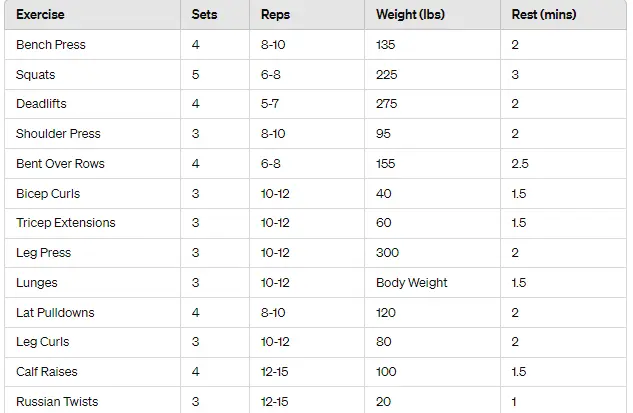Weightlifting is really popular because it helps people strengthen and strengthen their muscles. People of all the stars take it weight lifting chart. from the beginning to the experienced lifter They enjoy all the waters. One thing that everyone needs to know whether they are new or experienced is How to convert weight from pounds to kilograms. This skill locates the instruments in the body weight. And it helps us understand gym intentions. That’s where a weightlifting chart comes in.
It’s a tool that shows you how to quickly convert weights from pounds to kilograms. This chart is a must for anyone who lifts weights. Even if you start right now and try to learn about different weights. Or if you’re already experienced and want to fine-tune workouts and track your progress.
You can also use these chart outside the gym to plan workouts and stay on track with your fitness goals. weightlifting charts are really helpful tools that can make building strong muscles and staying fit easier for people all over the world.
Why Use a Weight Lifting Chart?
When you go to the gym for weight lifting, you may encounter weights measured in pounds or kilograms. This can be confusing, so measure the weight and check it. You’ve been following a weight plan, lifting weights, or tracking your fitness, and suddenly you’re stuck in a conversion dilemma. This is where a handy lbs to kg weightlifting chart comes in to save the day. It’s like your trusty sidekick. You have to make things easier by giving a clear guide on how to convert these numbers.
Whether you’re pumping iron to target specific muscles or aiming for specific fitness goals, having this chart with you ensures you’re on the right track without the confusion of all your weight. It’s all about making the elevator ride smoother and more accurate while helping you stay focused on achieving your goals.
Understanding the Conversion
Before diving into the lbs to kilograms weightlifting chart, let’s break down the conversion factor between pounds and kilograms. one pound is about 0.45 kilograms and one kilogram is about 2.2 pounds. If you’re trying to figure out how much weight you’re carrying in kilograms when it’s labeled pounds instead, you can use these conversion numbers to unravel the weight mystery. It’s like having a secret code that makes it easy to understand and navigate your exercise routine. With this knowledge under your belt, you’ll feel more confident in choosing the right weights and tracking your progress effectively.
Popular conversion Tools
The Lbs to Kg Weight Lifting Chart
Below is a sample lbs to kg weight lifting chart showcasing common weight increments typically found in gyms:

Using the Chart
If you’re planning a workout that requires you to lift 50 pounds for a specific workout, if you look at the LBS to kg weight lifting chart, you ‘ll find that 50 pounds is about 22.68 kg. This instead of trying to figure out what weight in kilograms is closest to what you need, you can just look at the chart. It becomes easier for the muscles to work property.
Examples and Formulas
Example 1: Converting Pounds to Kilograms
- Expect you want to convert 75 pounds to kilograms.
- Using the conversion formula:
- makefileCopy code
kilograms = pounds × 0.453592
- Working in the values:
make-file-Copy code
kilograms = 75 × 0.453592 ≈ 34.02
Therefore, 75 pounds is approximately equal to 34.02 kilograms.
2. Example 2: Converting Kilograms to Pounds
- Let’s convert 20 kilograms to pounds.
- Using the formula:
make-file-Copy code
pounds = kilograms × 2.20462
- Substituting the values:
make-file-Copy code
pounds = 20 × 2.20462 ≈ 44.0924
Therefore, 20 kilograms is approximately equal to 44.0924 pounds.
Conclusion
The pounds to kilograms’ weight lifting chart shortens the process of converting between weights and kilograms. By understanding the conversion factor, using the lick effectively and applying conversion formulas when needed, you can navigate your weightlifting journey with confidence. They can go and achieve their fitness goals with ease.
